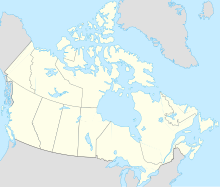Experimental Lakes Area
Coordinates: 49 ° 47 ′ N , 93 ° 49 ′ W
The Experimental Lakes Area ( ELA for short ) is a research facility of the DFO ( Department of Fisheries and Oceans ) in the Kenora District of Canada. This includes 58 lakes with their associated catchment areas and some additional smaller river sections. Ganzsee experiments were carried out in this area in order to gain a better understanding of aquatic ecosystems. Over the decades, experiments on an impressive scale have been carried out, such as the construction of a dam, the establishment of fish farms or the addition of environmental toxins to entire lakes. Many of the results of the experiments have found their way into environmental policy and significantly influenced areas of limnology , hydrology and climatology .
history
Since the 1960s, algal blooms increased in the Great Lakes as a result of the growing population and industry in the catchment area. This quickly became a serious problem for commercial fisheries. In 1966, the Freshwater Institute (FWI) was founded in Winnipeg with the task of studying the eutrophication of lakes. The then director W. E. Johnson was able to convince the governments of Canada and Ontario of the intention to find an explanation with the help of Ganzsee experiments. After a two-year search, an agreement was reached on the area in the Kenora District.
The first experiment began in June 1968 with the eutrophication of Lake 227. The findings led Canada to become the first country to ban phosphate detergents.
The station quickly developed from a makeshift camp to a permanent establishment with 30 buildings and 50 employees in the mid-1970s.
In 1979 the Freshwater Institute (FWI) was transferred to the Department of Fisheries and Oceans (DFO). This decision had far-reaching consequences for the ELA, as the DFO mainly dealt with problems in the marine area. This led to increasing problems in funding research.
In 1996, the ELA faced the end of the economy for the first time, but could be retained.
The manipulation of ecosystems
The importance of this form of ecological experiment lies in the fact that certain physical processes and organisms cannot be viewed on a reduced scale.
On the other hand, the repeatability of the experiment and the control of its conditions can no longer be guaranteed.
When the area of today's ELA was selected, attempts were made to include these factors. The lakes and the adjacent pine forests are all on granite stone, which minimizes the inflow of groundwater. In addition, a sparsely populated area with few development tendencies was deliberately selected. This should keep human influence to a minimum, except for those of scientific use.
Experiments with endocrine disruptors
The effects of adding ethinylestradiol were investigated . This synthetic contraceptive was added to Lake 223 in 2001 and its dosage (5-6 ng) corresponded to the frequently measured concentration in wastewater. The fish population of the American fathead minnow ( Pimephales promelas ) was examined. After a few weeks, the males became feminized in the form of an overproduction of female hormones ( vitellogenin ) and an altered development of the gonads. There was no longer any reproduction and the number of minnows was drastically reduced. After three years the experiment was stopped to prevent the population from disappearing.
outlook
Due to budget cuts by the Canadian government, the ELA should be closed on March 31, 2013. An initiative of Canadian scientists and concerned citizens tried to persuade the Stephen Harper government to give in through protests and petitions . In addition, an attempt was made to keep the ELA as an independent institution through fundraising. In April 2013 it was announced that ELA could continue to work for the time being. A month later, the DFO signed a letter of intent, on the basis of which the ELA is to be transferred to the International Institute for Sustainable Development (IISD). The Canadian non-governmental institute , which has been non-profit making since its inception , mainly conducts research in the field of sustainable development . IISD and ELA have been working together on a permanent basis since 2014.
swell
- Stokstad, Erik: Canada's Experimental Lakes ( July 31, 2013 memento in the Internet Archive ). In: Science . November 28, 2008, Vol. 322, No. 5906, pp. 1316-1319.
- Schindler, David William: A personal history of the Experimental Lakes Project. In: Canadian Journal of Fisheries and Aquatic Sciences. Vol. 66, 2009, doi : 10.1139 / f09-134 .
- IISD Experimental Lakes Area. Official website of the ELA.
Individual evidence
- ↑ cf. SaveELA.org: Save ELA - Experimental Lakes Area ( Memento from January 10, 2016 in the Internet Archive ).
- ^ Ontario Supporting the Experimental Lakes Area. New Government Working to Keep Ongoing Freshwater Research. (No longer available online.) In: news.ontario.ca. April 24, 2013, archived from the original on December 30, 2014 ; accessed on August 18, 2013 .
- ↑ IISD-ELA - Who we are. International Institute for Sustainable Development, accessed September 13, 2016.
literature
- Winfred Lampert, Ulrich Sommer : Limnökologie . Oxford University Press, Oxford, 2nd Edition, 1999, pp. 19-20.
Web links
- TV report by science.gc.ca ( Memento from September 13, 2007 in the Internet Archive )
- ELA website at iisd.org
